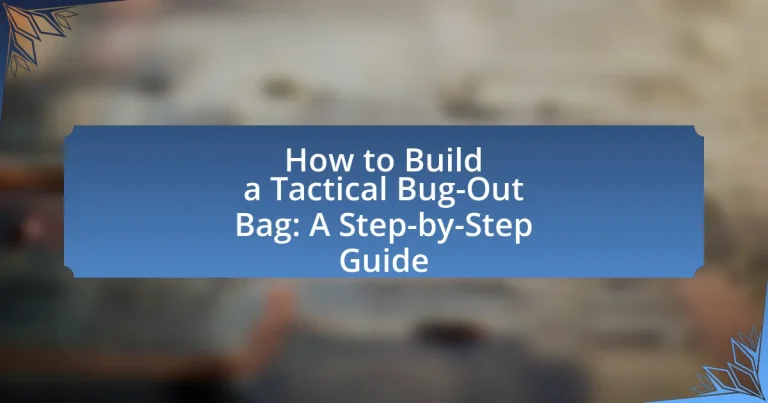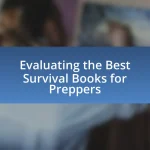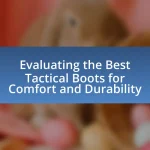A Tactical Bug-Out Bag is a specialized backpack designed to carry essential supplies for emergency situations, enabling quick evacuation. This article provides a comprehensive guide on building a Tactical Bug-Out Bag, detailing its importance, necessary components, and how to customize it based on individual needs and environmental factors. Key topics include prioritizing items, effective packing techniques, maintaining the bag, and avoiding common mistakes. The article emphasizes the significance of preparedness in enhancing survival rates during emergencies, offering practical steps for assembling a well-equipped and functional Bug-Out Bag.
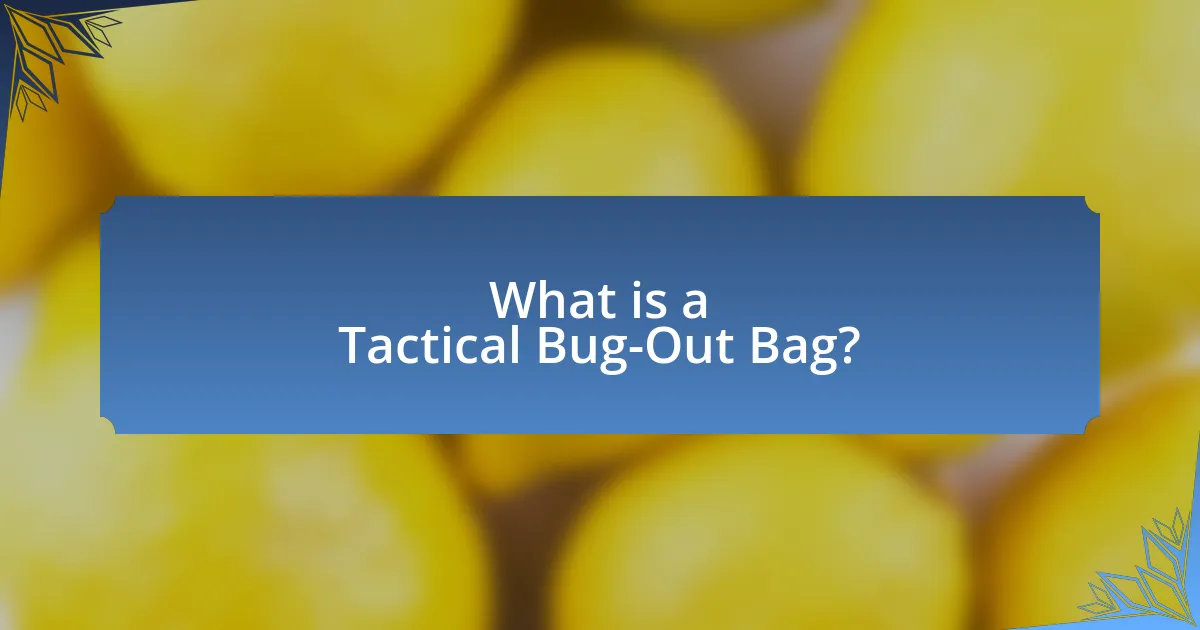
What is a Tactical Bug-Out Bag?
A Tactical Bug-Out Bag is a portable, organized backpack designed to carry essential supplies for emergency situations, enabling quick evacuation. This type of bag typically includes items such as food, water, first aid kits, tools, and personal defense equipment, all selected for their utility and efficiency in survival scenarios. The concept of a bug-out bag is rooted in preparedness strategies, emphasizing the importance of being ready to leave one’s home quickly in response to natural disasters, civil unrest, or other emergencies.
Why is a Tactical Bug-Out Bag important for emergencies?
A Tactical Bug-Out Bag is important for emergencies because it provides essential supplies and equipment needed for survival during unexpected situations. This type of bag is designed to be portable and organized, allowing individuals to quickly evacuate and sustain themselves in crises such as natural disasters, civil unrest, or other emergencies. The inclusion of critical items like food, water, first aid supplies, and tools ensures that individuals can meet their basic needs and respond effectively to challenges they may face. Studies show that preparedness significantly increases survival rates in emergencies, highlighting the necessity of having a well-equipped Tactical Bug-Out Bag readily available.
What situations necessitate the use of a Bug-Out Bag?
A Bug-Out Bag is necessary in situations such as natural disasters, civil unrest, or any emergency requiring immediate evacuation. These scenarios often involve sudden threats to safety, such as hurricanes, wildfires, or riots, where individuals must leave their homes quickly and be self-sufficient for a period. For instance, during Hurricane Katrina in 2005, many residents were forced to evacuate with little notice, highlighting the importance of being prepared with essential supplies readily available in a Bug-Out Bag.
How does a Tactical Bug-Out Bag differ from a regular backpack?
A Tactical Bug-Out Bag differs from a regular backpack primarily in its design and functionality tailored for emergency situations. Tactical Bug-Out Bags are constructed with durable, weather-resistant materials and feature multiple compartments for organized storage of survival gear, whereas regular backpacks typically prioritize comfort and casual use without specialized features. Additionally, Tactical Bug-Out Bags often include MOLLE (Modular Lightweight Load-carrying Equipment) webbing for attaching extra gear, which is not a standard feature in regular backpacks. These bags are specifically designed for quick access to essential items during crises, emphasizing preparedness and efficiency.
What are the essential components of a Tactical Bug-Out Bag?
The essential components of a Tactical Bug-Out Bag include water, food, first aid supplies, shelter, clothing, tools, and communication devices. Water is critical for survival, with a recommended minimum of one gallon per person per day. Non-perishable food items, such as energy bars or freeze-dried meals, provide necessary nutrition. A comprehensive first aid kit should contain bandages, antiseptics, and medications. Shelter components, like a lightweight tent or emergency blanket, protect against the elements. Clothing should be weather-appropriate and include extra layers. Tools, such as a multi-tool or knife, assist in various tasks, while communication devices, like a whistle or two-way radio, ensure connectivity. These components are vital for ensuring safety and survival in emergency situations.
What types of gear should be included in a Bug-Out Bag?
A Bug-Out Bag should include essential gear such as food, water, shelter, first aid supplies, tools, clothing, and personal documents. Food should be non-perishable and easy to prepare, while water should be in portable containers or purification systems. Shelter gear includes items like a tent or tarp for protection against the elements. First aid supplies must cover basic medical needs, including bandages and antiseptics. Tools should consist of a multi-tool or knife, and clothing should be weather-appropriate and durable. Personal documents, such as identification and emergency contacts, are crucial for re-establishing identity and accessing resources. These items collectively ensure survival and safety in emergency situations.
How do you prioritize items for your Bug-Out Bag?
To prioritize items for a Bug-Out Bag, focus on essential survival needs such as water, food, shelter, first aid, and tools. Water is critical, as humans can only survive a few days without it; therefore, include water purification methods. Food should be lightweight and high in calories, such as energy bars or dehydrated meals, to sustain energy during an emergency. Shelter items, like a compact tarp or emergency blanket, provide protection from the elements. A well-stocked first aid kit is vital for treating injuries, and multi-tools or knives are necessary for various tasks. Prioritizing these categories ensures that the most critical survival needs are met first, enhancing the chances of survival in an emergency situation.
How can you customize your Tactical Bug-Out Bag?
To customize your Tactical Bug-Out Bag, assess your specific needs based on potential scenarios you may face, such as natural disasters or urban emergencies. Tailor the contents by including essential items like food, water, first aid supplies, and tools that align with your personal skills and preferences. For instance, if you have medical training, prioritize advanced first aid supplies; if you are skilled in outdoor survival, include gear for shelter and navigation. Additionally, adjust the bag’s organization using modular pouches or compartments to enhance accessibility and efficiency. This approach ensures that your Tactical Bug-Out Bag is not only functional but also uniquely suited to your individual requirements and circumstances.
What factors should influence your customization choices?
Customization choices for a tactical bug-out bag should be influenced by individual needs, environmental conditions, and specific scenarios. Individual needs include personal health, physical capabilities, and preferences for gear types, which dictate the weight and functionality of the bag. Environmental conditions, such as climate and terrain, determine the types of clothing, shelter, and survival gear required. Specific scenarios, like urban versus wilderness survival, influence the selection of tools and supplies, ensuring preparedness for various emergencies. These factors collectively ensure that the customization aligns with practical survival requirements and personal readiness.
How can personal needs and environment affect your Bug-Out Bag setup?
Personal needs and environment significantly influence the setup of a Bug-Out Bag by determining the specific items required for survival and the conditions under which those items will be used. For instance, an individual with dietary restrictions may need to include specialized food supplies, while someone living in a cold climate must prioritize thermal clothing and gear. Additionally, the environment dictates the necessity for tools suited to local terrain, such as a compass for wilderness navigation or urban survival gear for city dwellers. Research indicates that preparedness plans, including Bug-Out Bag contents, should be tailored to individual circumstances and environmental factors to enhance survival chances during emergencies.
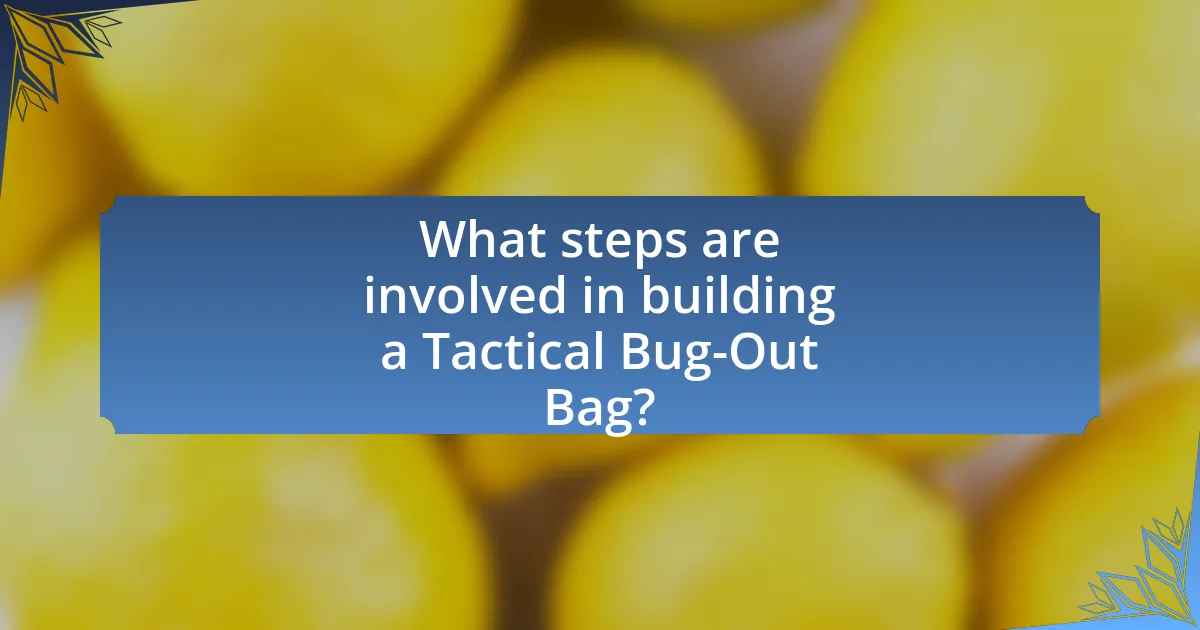
What steps are involved in building a Tactical Bug-Out Bag?
Building a Tactical Bug-Out Bag involves several key steps: assessing personal needs, selecting a suitable bag, gathering essential gear, organizing items efficiently, and regularly reviewing and updating the contents.
First, individuals must assess their specific needs based on potential emergencies, such as natural disasters or civil unrest, which informs the type and quantity of supplies required. Next, selecting a durable and functional bag, typically a backpack with multiple compartments, ensures ease of transport and access to items.
Gathering essential gear includes food, water, first aid supplies, tools, clothing, and personal documents, all tailored to the anticipated duration of the emergency. Organizing items efficiently within the bag enhances accessibility and weight distribution, which is crucial for mobility. Finally, regularly reviewing and updating the contents of the bag ensures that supplies remain relevant and usable, adapting to changing circumstances or personal needs.
These steps are critical for creating a Tactical Bug-Out Bag that effectively prepares individuals for emergencies.
How do you select the right bag for your needs?
To select the right bag for your needs, first assess the specific purpose and requirements of your bug-out situation. Consider factors such as capacity, durability, weight, and comfort. For example, a bag with a capacity of 30-50 liters is typically suitable for a short-term bug-out scenario, while a larger bag may be necessary for extended stays. Additionally, materials like nylon or polyester provide durability against wear and weather. Comfort features, such as padded straps and a supportive frame, enhance usability during transport. Research indicates that bags designed for tactical use often include modular systems, allowing for customization based on individual needs, which can be crucial in emergency situations.
What features should you look for in a Tactical Bug-Out Bag?
A Tactical Bug-Out Bag should have durability, ample storage, organization, comfort, and versatility. Durability is essential, as the bag must withstand harsh conditions; materials like 1000D nylon are commonly used for their strength. Ample storage allows for carrying essential gear, typically featuring multiple compartments and pockets for organization. Comfort is crucial for extended wear, which is achieved through padded shoulder straps and a supportive back panel. Versatility ensures the bag can adapt to various situations, often including MOLLE webbing for attaching additional gear. These features collectively enhance the bag’s functionality and reliability in emergency scenarios.
How does size impact your Bug-Out Bag’s effectiveness?
The size of a Bug-Out Bag directly impacts its effectiveness by determining the amount of essential gear and supplies it can carry. A larger bag can accommodate more items, allowing for a wider range of survival tools, food, water, and medical supplies, which are crucial in emergency situations. Conversely, a smaller bag may limit the quantity and variety of items, potentially compromising preparedness. Research indicates that a well-sized Bug-Out Bag should balance capacity with weight; for instance, a bag that exceeds 20% of a person’s body weight can lead to fatigue and hinder mobility, reducing overall effectiveness in a crisis.
What items should you include in your Bug-Out Bag?
A Bug-Out Bag should include essential items for survival in emergency situations. Key items are water purification systems, non-perishable food, a first aid kit, a multi-tool, a flashlight with extra batteries, a fire starter, a map and compass, a durable backpack, clothing suitable for the environment, and a means of communication. These items are crucial as they provide hydration, nutrition, medical assistance, tools for various tasks, light, warmth, navigation, and connectivity, which are vital for survival and safety during an unexpected evacuation.
How do you choose food and water supplies for your Bug-Out Bag?
To choose food and water supplies for your Bug-Out Bag, prioritize lightweight, non-perishable items that provide high energy and hydration. Select foods like energy bars, dehydrated meals, and canned goods that have a long shelf life and require minimal preparation. For water, include portable filtration systems or purification tablets to ensure access to safe drinking water. According to the U.S. Department of Homeland Security, having at least one gallon of water per person per day for at least three days is essential for emergency preparedness. This approach ensures that your supplies are practical, efficient, and capable of sustaining you during an emergency situation.
What first aid supplies are essential for a Tactical Bug-Out Bag?
Essential first aid supplies for a Tactical Bug-Out Bag include a comprehensive first aid kit, adhesive bandages, antiseptic wipes, gauze pads, medical tape, scissors, tweezers, a tourniquet, and pain relievers. These items are critical for treating injuries and managing medical emergencies in survival situations. A well-stocked first aid kit can significantly increase the chances of survival by providing necessary care for cuts, scrapes, and more severe injuries, as evidenced by emergency preparedness guidelines from organizations like the American Red Cross.
How can you effectively pack your Tactical Bug-Out Bag?
To effectively pack your Tactical Bug-Out Bag, prioritize essential items based on your specific needs and the potential scenarios you may face. Start by categorizing gear into sections: shelter, food, water, first aid, tools, and personal items. For instance, include a lightweight tent or tarp for shelter, high-calorie food bars for nutrition, and a reliable water filtration system for hydration.
Organize these items by frequency of use, placing the most critical gear at the top or in easily accessible pockets. For example, keep your first aid kit and multi-tool readily available. Additionally, use packing cubes or dry bags to separate categories and maintain organization. This method not only maximizes space but also ensures quick access during emergencies.
Research indicates that a well-organized bug-out bag can significantly enhance survival chances in crisis situations, as it allows for efficient retrieval of necessary items (Survival Research Institute, 2021).
What packing techniques maximize space and accessibility?
Efficient packing techniques that maximize space and accessibility include the use of compression bags, rolling clothes, and strategic layering. Compression bags reduce the volume of clothing and soft items, allowing for more efficient use of space. Rolling clothes instead of folding them minimizes wrinkles and maximizes packing density. Additionally, layering items by weight and frequency of use ensures that the most accessible items are on top, facilitating quick access during emergencies. These methods are supported by studies indicating that organized packing can increase storage efficiency by up to 30%.
How do you ensure weight distribution is balanced in your Bug-Out Bag?
To ensure weight distribution is balanced in a Bug-Out Bag, place heavier items close to the back and center of the bag. This positioning lowers the center of gravity, enhancing stability and comfort during movement. Additionally, distribute lighter items towards the top and sides to maintain balance and prevent shifting while walking. Research indicates that proper weight distribution can reduce fatigue and improve mobility, making it essential for effective bug-out scenarios.
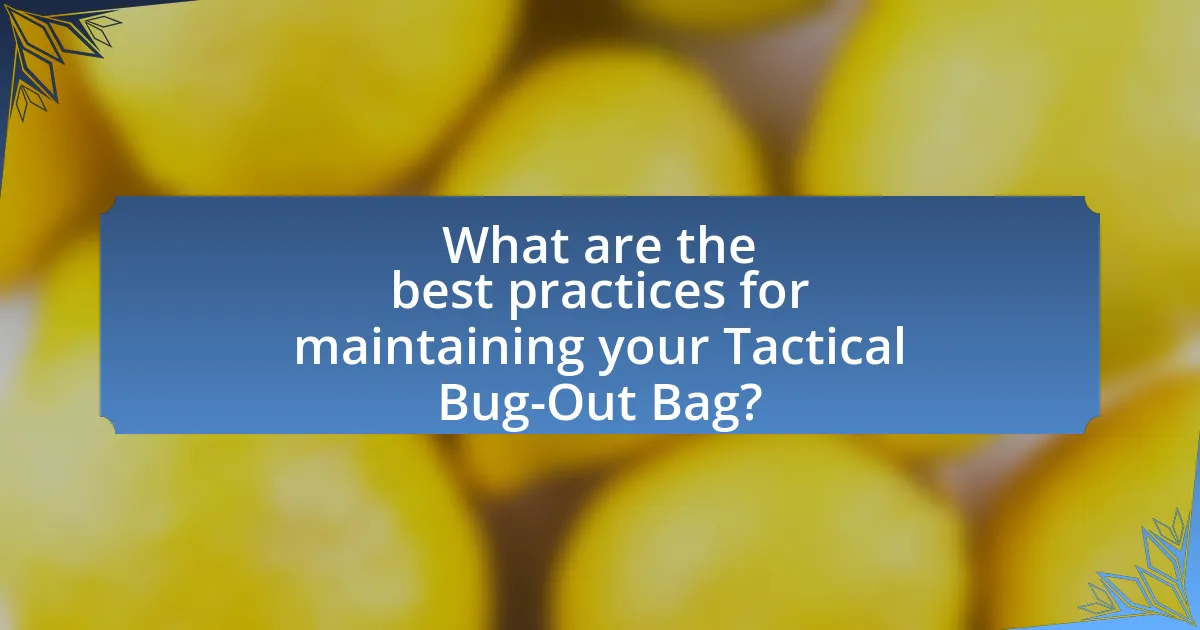
What are the best practices for maintaining your Tactical Bug-Out Bag?
To maintain your Tactical Bug-Out Bag effectively, regularly inspect and update its contents to ensure all items are functional and relevant. This includes checking expiration dates on food and medical supplies, replacing batteries in flashlights and radios, and ensuring that gear is in good working condition. Additionally, practice repacking the bag periodically to familiarize yourself with its contents and to ensure that everything fits properly, which enhances accessibility in an emergency. Keeping the bag clean and stored in a dry, cool place also prevents damage and deterioration of materials. Regular maintenance ensures that your Tactical Bug-Out Bag remains ready for immediate use when needed.
How often should you review and update your Bug-Out Bag?
You should review and update your Bug-Out Bag at least every six months. Regular reviews ensure that the contents remain relevant and functional, considering factors such as seasonal changes, expiration dates of food and medical supplies, and personal needs that may evolve over time. Research indicates that preparedness kits, including Bug-Out Bags, should be assessed biannually to maintain effectiveness in emergency situations.
What signs indicate that your Bug-Out Bag needs to be refreshed?
Signs that indicate your Bug-Out Bag needs to be refreshed include expired food and medical supplies, damaged or worn-out gear, and outdated maps or emergency contacts. Expired items can compromise safety and effectiveness, while damaged gear may fail when needed most. Regularly checking these components ensures that the bag remains reliable and ready for emergencies.
How can you keep track of expiration dates for supplies?
To keep track of expiration dates for supplies, implement a systematic inventory management system. This can be achieved by labeling each item with its expiration date upon purchase and regularly reviewing the inventory to remove expired items. Research indicates that using digital tools, such as inventory management apps, can enhance tracking efficiency and accuracy, allowing users to set reminders for upcoming expirations. This method ensures that supplies remain safe and effective for use, reducing waste and maintaining preparedness.
What common mistakes should you avoid when building a Bug-Out Bag?
When building a Bug-Out Bag, common mistakes to avoid include overpacking, neglecting essential items, and failing to customize the bag for individual needs. Overpacking can lead to unnecessary weight, making it difficult to carry in an emergency. Neglecting essential items, such as first aid supplies, food, and water, can leave individuals unprepared for survival situations. Additionally, failing to customize the bag based on personal circumstances, such as location, climate, and family needs, can result in a lack of effectiveness during an emergency. These mistakes can significantly impact the bag’s utility and the individual’s ability to respond effectively in a crisis.
How can overpacking affect your Bug-Out Bag’s effectiveness?
Overpacking can significantly reduce your Bug-Out Bag’s effectiveness by making it heavier and less manageable. A heavier bag can lead to fatigue, slower movement, and decreased agility, which are critical in emergency situations. Studies show that carrying excessive weight can increase the risk of injury and decrease overall performance, particularly in high-stress scenarios. Additionally, overpacking can lead to difficulty in accessing essential items quickly, as a cluttered bag complicates organization and retrieval. Therefore, maintaining an optimal weight and carefully selecting items is crucial for ensuring your Bug-Out Bag remains functional and effective in emergencies.
What are the risks of neglecting to tailor your Bug-Out Bag to your needs?
Neglecting to tailor your Bug-Out Bag to your needs can lead to inadequate preparedness during emergencies. A Bug-Out Bag that does not reflect personal requirements may lack essential items, such as specific medications, clothing suited for the climate, or tools necessary for survival in particular environments. For instance, a study by the Federal Emergency Management Agency (FEMA) emphasizes the importance of personalized emergency kits, noting that 60% of individuals who prepare tailored kits feel more confident in their ability to respond to crises. This lack of customization can result in increased vulnerability, reduced efficiency in emergency situations, and ultimately, a higher risk of injury or failure to survive.
What tips can enhance your Bug-Out Bag preparedness?
To enhance your Bug-Out Bag preparedness, prioritize essential items such as water, food, first aid supplies, and tools. Ensuring that your bag contains at least one gallon of water per person per day for three days is crucial, as hydration is vital for survival. Additionally, include non-perishable food items that provide sufficient calories, such as energy bars or freeze-dried meals, to sustain energy levels during emergencies. A well-stocked first aid kit should contain bandages, antiseptics, and medications tailored to your family’s needs, as injuries can occur in crisis situations. Furthermore, incorporating multi-tools or survival gear can aid in various tasks, from building shelter to food preparation. Regularly review and update your Bug-Out Bag to ensure all items are functional and within expiration dates, as this practice maintains readiness for unforeseen events.
How can regular drills improve your readiness with a Bug-Out Bag?
Regular drills enhance your readiness with a Bug-Out Bag by allowing you to practice the skills necessary for effective emergency response. Engaging in these drills helps familiarize you with the contents of your Bug-Out Bag, ensuring you know where essential items are located and how to use them efficiently. For instance, a study by the National Fire Protection Association indicates that regular practice can significantly reduce response times in emergencies, which is crucial when time is limited. Additionally, drills can reveal any gaps in your preparedness, prompting necessary adjustments to your Bug-Out Bag, such as adding missing supplies or replacing expired items. This continuous improvement cycle ensures that you remain ready for various emergency scenarios.
What resources can help you stay informed about Bug-Out Bag essentials?
Online forums and websites dedicated to survivalism, such as Survivalist Boards and The Prepared, provide valuable insights into Bug-Out Bag essentials. These platforms feature discussions, articles, and user experiences that help individuals understand the necessary items and strategies for effective preparedness. Additionally, books like “The Ultimate Bug-Out Bag” by Scott Finazzo and “Bug Out: The Complete Plan for Escaping a Catastrophic Disaster Before It’s Too Late” by Scott B. Williams offer comprehensive guides on assembling Bug-Out Bags. These resources are widely recognized in the survival community for their practical advice and detailed checklists, ensuring that readers stay informed about the latest trends and recommendations in Bug-Out Bag essentials.
